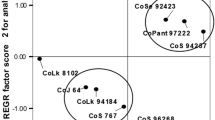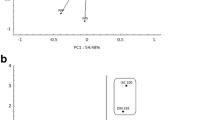Abstract
Two types of failures of attack by the top borer, Scirpophaga excerptalis Wlk., and their relation to sugarcane resistance to deadheart formation were studied in 164 genotypes of sugarcane for three years at two locations, viz., Karnal (Haryana State) and Chakia (Bihar State) in India. Attacks were unsuccessful either because of failure of neonate larvae in the mid-rib to reach the spindle (Type 1) or failure of older larvae in the spindle to reach the meristem (Type 2). Type 1 failure was frequent (19.2 to 26.7 %) while Type 2 was rare (2.9 to 5.1 %) among the genotypes. Larval dispersal and mortality were influenced by several factors related or unrelated to resistance and occurred concurrently in the same genotypes. This led to variation in larval mortality even among genotypes with the same levels of Type 1 failure. Those genotypes (Co 1223, Co 1224, E 276, Co 7224, Co 745, E 128, Co 62235, E 132, E 50, CoS 767 and CoJ 67) that had high scores of both Type 1 failure (14 to 18) and larval mortality (13 to 17) had the lowest percentages of deadhearts (11.8 to 24.4%).
Type 2 failure was not related to resistance; the highly resistant genotypes, Co 1223, Co 1224, E 276, Co 62235, E 132, CoS 767 and F133, showed no Type 2 failure. Furthermore, genotypes IA 3017 and Co 7322 which had the highest Type 2 failure scores of 9 and 12 respectively, had 61 and 36% deadhearts respectively. It is concluded that Type 2 failure may be caused by larval mortality in the spindles due to diseases and/or asphyxiation by accumulated rain water.
Résumé
Deux types d’échec d’attaque par le foreur de bourgeon, Scirpophaga excerptalis Wlk., et leur rôle dans la résistance à la pourriture du coeur de la canne à sucre ont été étudiés. L’étude a duré 3 ans et elle a porté sur 164 génotypes de canne à sucre, dans deux localités en Inde, à savoir Karnal (Etat de Haryiana) et Chakia (Etat de Bihar). Les attaques avortaient soit suite à ce que les larves neonates situées dans la nervure centrale n’arrivaient pas à atteindre le fusain (Type 1) ou bien les larves plus âgées, à l’intérieur du fusain, ne parvenaient pas à atteindre le méristème (Type 2). Au sein des génotypes, l’échec du type 1 était fréquent (19, 2–26, 7%), tandis que celui du type 2 était plutôt rare (2, 9–5, 1%). La dispersion des larves et leur mortalité étaient influencées par plusieurs facteurs liés ou non liés à la résistance, et ils étaient simultanés chez certains génotypes. Ce fait induisait une variation de mortalité larvaire même au sein des génotypes avec les mêmes niveaux d’échec d’attaque du type 1. Les génotypes Co 1223, Co 1224, E 276, Co 7224, Co 745, E 128, Co 62235, E 132, E 50, CoS 767 et CoJ 67 qui avaient des niveaux hauts d’échec du type 1 (14–18%) et une mortalité larvaire élevée (13–17%), montraient aussi les pourcentages le plus bas en pourriture de coeur (11, 8–24, 4%).
L’échec du type 2 n’étaient pas lié à la résistance puisque les génotypes hautement résistants Co 1223, Co 1224, E 276, Co 62235, E132, CoS 767 et F133 n’ont pas montré des signes du type 2. De plus, les génotypes IA 3017 et Co 7322 qui avec plus de scores du type 2 (9 et 12 points respectivement), avaient aussi 61 et 36% de pourriture de coeur, respectivement. De-là, on a conclu que l’échec du type 2 pourrait résulter de la mortalité larvaire à l’intérieur des fusains. Cette mortalité serait causée par des maladies et/ou par des asphyxies des larves due à l’accumulation d’eau de pluie dans les fusains.
Similar content being viewed by others
References
Adlakha, P. A. (1964) Studies of the various factors responsible for resistance to top borer in the different varieties of sugarcane. Indian, J. Sugarcane Res. Dev. 8, 343–344.
Avasthy, P. N. (1969) The top borer of sugarcane, Scirpophaga nivella F., pp. 187–200. In Pests of Sugarcane (Edited by J. R. Williams, J. R. Metcalfe, R. W. Mungomery and, R. Mathes). Elsevier Publishing Co., Amsterdam.
Avasthy, P. N. (1981) Stalk borer, Chilo anricilius Dudg. management in sugarcane. Proc. Nat. Symp. Stalk Borer, Haryana Agric. Univ. Reg. Stn Karnal. pp. 31–42.
Chaudhary, J. P. and Yadav, S. R. (1996) Effect of total sugar and reducing sugar present in the midribs and growing points and leaf blades of sugarcane genotypes on incidence of top borer Scirpophaga excerplalis (Wlk.). Indian Sng. 46, 867–875.
Clements, H. F. and Ghotb, A. (1969) The numbering of leaves and internodes for sugarcane nutrition studies. Proc. 13th Congr. Int. Soc. Sug. Cane Technol. 1968. Taiwan, pp. 569–584.
Dev Roy, T. C. and Bains, S. S. (1983) Key mortality factors in the population dynamics of sugarcane top borer, Tryporyza nivella (Fab.) in the Punjab, pp. 270–283. In Proceedings of the Symposium on Insect Ecology and Management (Edited by S. C. Goel). P. G. Department of Zoology, Sanatan Dharm College, Muzaffarnagar-251 001 India.
Gupta, B. D. (1959) Insect pests of sugarcane in India. III. The top borer, Scirpophaga nivella F. Indian Sug. 9, 127–149.
Gupta, B. D. and Avasthy, P. N. (1954) A résumé on the behaviour of varieties towards the incidence of major pests of sugarcane in Uttar Pradesh and other states in India (1946–1951). Proc. Bienn. Conf. Sug. Cane Res.Dev.Wors. 2, 208–228.
Hart, P. C. (1932) Top borer attack in relation to hardness of growing point of POJ 2878. Facts about Sugar. 28, 35–37.
Hazelhoff, E. H. (1932) Investigations on the white top borer. Proc. ïnt. Soc. Sug. Cane Technol. J., Bulletin 66, 8
Huque, M. W. and Agarwala, S. B. D. (1955) Biological studies on top borer (Scirpophaga nivella Fab.). Indian Sug. 5, 13–20.
Isaac, P. V. (1939) How mid rib hardness affords resistance to the sugarcane top borer in India. Curr. Sci. 8, 211–212.
Kalra, A. N. and Chaudhary, J. P. (1964) Infructuous attack of top borer of sugarcane. Indian, J. Sugarcane Res. Dev. 8, 345–346.
Kalra, A. N. and Mahesh Prasad (1978) Infructuous attack of sugarcane top borer. Indian Sug. Crops, J.. 7, 79–81.
Khanna, K. L. and Ramanathan, K. R. (1946) Studies on the association of plant characters and pest incidence II. On the relationship between spindle length and varietal resistance to top borer attack in sugarcane. Indian, J. Entomol. 8, 178–185.
Mukunthan, N. (1984) Tensile strength of mid ribs in relation to the top borer resistance. Proc. A. Conv. Deccan Sug. Technol. Assoc. 34, 109–116.
Mukunthan, N. (1985) New aspects in the biology of top borer Scirpophaga nivella F. Entomon 10, 235–238.
Mukunthan, N. (1988) Growth rate of sugarcane and its resistance to top borer. Sugarcane (Autumn Supplement) pp. 1–3.
Mukunthan, N. (1989) Life tables of sugarcane top borer, Scirpophaga Excerptalis Wlk. Insect Sci. Applic. 10, 269–276.
Mukunthan, N. (1990) Resistance studies in sugarcane top borer, Scirpophaga Excerptalis Wlk. PhD thesis, Tamil Nadu Agricultural University, Coimbatore, India.
Mukunthan, N. (1996) Development of top borer on different host plants. Sugarcane 6, 11–13.
Patel, R. M. (1963) Observations on the life history and control of sugarcane top borer (Scirpophaga nivella F.) in South Gujarat. Indian, J. Sugarcane Res. Dev. 850–855.
Steel, R. G. D. and Torrie, J. H. (1960) Some discrete distributions, pp. 388–399. In Principles and Procedures of Statistics. McGraw-Hill Book Company Inc., New York.
Singh, K., Verma, A. and Mitra, K. (1984) Larval feeding behaviour of top borer, Scirpophaga nivella F. in relation to growth of sugarcane plant. Entomon 9, 69–70.
Singla, M. L., Dhura, M. S. and Aulakh, M. S. (1988) Varietal resistance to Scirpophaga Excerptalis Wlk. and Odontotermes spp. J. Insect Sci. 1, 99–101.
Soedjono Darmodjo, I. R. (1975) Resistance of cane varieties to top borer infection. International Society of Sugarcane Technologists. Sugarcane Breeding Newsletter 36, 45–51.
Yadav, S. R. (1985) Screening of sugarcane genotypes for infestation by top borer, Tnjporyza nivella F. and characterisation of susceptibility. PhD Thesis, Haryana Agricultural University, Hissar, India.
Walker, H. M. and Joseph Lev (1974) Elementary Statistical Methods. Oxford and IBH Publishing Co., New Delhi 302 pp.
Author information
Authors and Affiliations
Corresponding author
Rights and permissions
About this article
Cite this article
Mukunthan, N., Mohanasundaram, M. Failures of Attack by the Top Borer, Scirpophaga excerptalis Wlk. In Relation to Resistance in Sugarcane Genotypes. Int J Trop Insect Sci 18, 293–300 (1998). https://doi.org/10.1017/S1742758400018518
Accepted:
Published:
Issue Date:
DOI: https://doi.org/10.1017/S1742758400018518




